Country Mouse
11.15.202I am taking an architecture class about rural living with a
professor, Adriano, who I met randomly one day. I was teaching an English lesson in an empty architecture room and he popped his head in. We talked for a couple of minutes and I found myself wanting to share my whole life story with him. Later that day, my friend, Lara, told me that she was taking a class about rural architecture with a cool professor, Adriano, and asked if I wanted to join. I’ve been learning to listen to my gut and follow the paths that feel good when they preset themselves to me. Learning to trust these little moments.
The next day I went to the first day of the class, during which we were planning a field trip to visit different sites in the countryside near Belo Horizonte. It is an undergraduate class, which I really like expereincing. The longer I spend here, the more energy I accumulate to teach, especially undergraduates.
The next week, on a typical summer (November) Monday (sunny in the morning and torrential downpours in the evenings), we piled into two rental cars and rumbled down mud roads to visit the four different sites.Adriano designed two of the four structures we visited and had personal relationships with all of the hosts.
As the day progressed, I started to realize that this trip was becoming very influential on me. When I reflected later in bed, spent, but deeply fulfilled, I organized the influence into two streams.
First, I have a very urban lens on architecture that shifted as I interacted with rural space. When I think about urban design and nature, I immediately think about how to integrate green elements into cities. I almost never work in rural regions or think about who lives there. Hard truth of a CITY GURL.
Leaving the city on that Monday allowed me to breath when I didn’t realize I was holding my breath. Winding down the mountain roads brought much peace during a time when I’ve been feeling a lot of internal turmoil. The past couple of weeks have been the rockiest I’ve had since being here, and I find myself feeling like I’m coming up quickly to a limit of structure-less-ness. I’m coming out of this Fulbright and looking to what comes next, where, and with whom, big questions that are proving harder to answer than I anticipated. Up until this point, I’ve been coasting along on the Fulbright and feeling purposeful as I was realizing many of the goals I had set out for myself. However, now I am at a point where my internal timeline is running out, and, for the first time in my life, I am facing myself, truly plan-less.
Beyond leaving the noise and speed city for the clean air and slowness of rural space, I also felt a release of tension listening to the stories of the various people we met along the way, most of whom themselves chose to leave the city and live permanently in the countryside. There are always other ways to be, a reminder which helps me put into perspective my decisions. In life, we need to make decisions and then we can adapt as we go along. As someone smart said once, the only thing constant in life is change.
Living closer with thick, dense, and wild nature, like what we witnessed on the visits, can provide this perspective. Natural cycles happen on their own time, and they are always changing, but have consistencies that allow life to keep flourishing. Being in the houses and on the verandas of the houses we visited reminded me that living with nature’s constant reminder of change slows down the breakneck speed of my mind and the pressure I put on myself to make decisions.
The second major influence was witnessing the professor, Adriano, interact with his clients/friends/students along the way. This was so inspiring because I saw myself in him. I’ve been learning to pay attention to the people who make sense to me. There are some people who, when they speak, make profound sense. This sense is only heightened in Portuguese, because it really means something when I feel like I not only understand the words of someone but also their deeper sentiments, the poetry behind the words. Adriano is an incredibly dynamic sixty-year old architect, professor, artist, and father of four sons, one of whom we met on the field trip. I’ve also learned that he has had wives as well as a long-term male partner, a fluidity which is reflected in the way that he designed both the houses we visited as well as the relationships that provided the foundation for the designs.
The houses were small and built on very small budgets, but had very tasteful design. They were very permeable to the outside, but still cozy, an element that was tested when the downpours started. We arrive at the last visit in the dark, feet sopping from the soggy hike up to the house, eyes tired from a full day. But when we finally landed in the kitchen of the hosts, we passed around cachaça (sugar cane liquor) and homemade sourkrout (made in a homemade sourkrout maker), quickly warming up as the rain crashed into the high roof. Large book cases and experiments in ceramics were spread around the space, and I immediately felt at home, thinking of the ceramic wheel at my Aunt Priscilla’s house and imagining that my sculptor grandfather would have loved the space as well.
In tangent with the quality of the designs was the beauty of the relationships Adriano had with the different families. He always said that he was but one of the designers in the projects, and always works with local craftsmen to build the home. It was evident that he is so admired by the people we visited, we were received with such openness and he wove together the purpose of our class with the relationships he had with the visits. I can tell that he lives out his politics in the warmth that he has for humans. He isn’t necessarily building massive affordable housing complexes, but he works with people to design homes that fit their needs in a way that builds positive relationships with the existing human and natural context. It feels like he is living his values in a deep way. Our conversations both talked about the roof strucutre as well as the challenges of being a newcomer in a region that distrusts outsiders as well as how he integrated indigenous knowledge which he learns through a partnership he built between the architecture school and a local indigenous community as well as how his ex-wife lived in one of the houses as well as how the roads are dangerous during the rains as well as how the greatest risk to everyone we met is the collapse of a nearby dam that would destroy everything. The shift of scale between the social, the political, and the technical, and united by underlying aspirations for how the world could be and beliefs about how to treat people with respect and dignity, makes deep sense to me. That was ar un-on sentance i know i know
The next day, I had my weekly therapy session with my therapist who lives in Canada but happens to be from Belo Horizonte, where she studied architecture. As I was talking in the session, I felt a little tug to tell my therapist about the field trip. She paused and asked to see a photo of him. It turns out she was his student decades ago, and told me that he was always such a dynamic and interesting person. She said that it makes sense that he had such a strong impact on me because, she said, “Lydia, you too are not a very typical person.” I always push back, asking, “but isn’t everyone not very typical, in their own ways?” She responded saying that not everyone is so focused on self-evolution, on seeking answers for the big questions, on living such a fluid life. She added that it can be lonely, painful, and hard to being on the outskirts of the norm, but that, if it is your truth, then you should follow it and it will bear it’s fruit. One day when I am rich and famous I will tell Adriano that I am a fruit of his journey.
In conclusion, choose to believe that most things happen for a reason. I think Adriano came into my life to show me about ways to be an adult in the world and live your truth even if it’s different from most. He showed me how to be an architect that doesn’t require a $300k degree, he showed me how to build passively, how to design ceramic studios in the rainforest, how to laugh and dance in front of thirty students, how to ask thoughtful questions, how to trust the process, how to be patient, and how to not be typical, humbly.
And now, photos...
Site Visit 1: Vitor, Adriano’s son in Casa Branca, Minas Gerais, Brazil
![]() The house in the background, Adriano and Vitor in the foreground
The house in the background, Adriano and Vitor in the foreground
![]() Adriano listening to Vitor talk about... something... probably architecture
Adriano listening to Vitor talk about... something... probably architecture
![]() My friend Lara on the back porch.
My friend Lara on the back porch.
Site Visit 2: Rebecca, her son and her partner in Casa Branca, Minas Gerais, Brazil. Jessica is SO COOL. She has a phd in agroecology and is currently an elementary school science teacher, with aspirations to integrate education and science. She currently drives over three hours every day to get to the school she teaches at, which is in Belo Horizonte. She lives with her family almost completely self-sufficiently. And she is beautiful and nice and smart and chill. So cool.
![]()
Rebecca with all her baby plants
![]() Rebecca’s son who got a mosquito bite and then rubbed a special kind of dirt on the bump to ease the itch
Rebecca’s son who got a mosquito bite and then rubbed a special kind of dirt on the bump to ease the itch
Site Visit 3: Jéssica e Bebeto, a couple who has a ceramic studio that uses Japanese ceramic techniques and mixes it with forms, clay, and dyes from Minas Gerais. Jessica is from Aglomerado da Serra, a community/occupation (favela) in Belo Horizonte and started doing ceramics as a teenager in a course there. Bebeto is from somewhere else that I didn’t understand... I think a rural town in Minas Gerais?
![]()
Jessica and her assistant glazing
![]() Bebeto in their shop @www.instagram.com/saracuratrespotes/
Bebeto in their shop @www.instagram.com/saracuratrespotes/
![]() Jessica and Bebeto talking on their veranda with cheese, cornbread, cachaça, pão de queijo and cigars in the foreground
Jessica and Bebeto talking on their veranda with cheese, cornbread, cachaça, pão de queijo and cigars in the foreground
![]() Pink chimney is a heater that heats the hottub (next photo)
Pink chimney is a heater that heats the hottub (next photo)
![]()
Hot tub
![]()
Dishes set out to dry on the veranda
![]()
Back of the author’s head, foreground
![]()
Ceramic studio
![]()
Ceramic studio
![]()
Adjacent kitchen to the ceramic studio
![]()
Joseane with her poncho in the kitchen
![]() I love the blue of these windows and the dark clay of the pots in the foreground. The pots are an ancient sugar-making tool.
I love the blue of these windows and the dark clay of the pots in the foreground. The pots are an ancient sugar-making tool.
![]() View from the ceramic studio into the kitchen. Joseane sitting at the table.
View from the ceramic studio into the kitchen. Joseane sitting at the table.
![]()
Adriano walking into the exhibition space behind the house.
![]()
Benedickt and Adriano
↩️ Return to Blog
The next day I went to the first day of the class, during which we were planning a field trip to visit different sites in the countryside near Belo Horizonte. It is an undergraduate class, which I really like expereincing. The longer I spend here, the more energy I accumulate to teach, especially undergraduates.
The next week, on a typical summer (November) Monday (sunny in the morning and torrential downpours in the evenings), we piled into two rental cars and rumbled down mud roads to visit the four different sites.Adriano designed two of the four structures we visited and had personal relationships with all of the hosts.
As the day progressed, I started to realize that this trip was becoming very influential on me. When I reflected later in bed, spent, but deeply fulfilled, I organized the influence into two streams.
First, I have a very urban lens on architecture that shifted as I interacted with rural space. When I think about urban design and nature, I immediately think about how to integrate green elements into cities. I almost never work in rural regions or think about who lives there. Hard truth of a CITY GURL.
Leaving the city on that Monday allowed me to breath when I didn’t realize I was holding my breath. Winding down the mountain roads brought much peace during a time when I’ve been feeling a lot of internal turmoil. The past couple of weeks have been the rockiest I’ve had since being here, and I find myself feeling like I’m coming up quickly to a limit of structure-less-ness. I’m coming out of this Fulbright and looking to what comes next, where, and with whom, big questions that are proving harder to answer than I anticipated. Up until this point, I’ve been coasting along on the Fulbright and feeling purposeful as I was realizing many of the goals I had set out for myself. However, now I am at a point where my internal timeline is running out, and, for the first time in my life, I am facing myself, truly plan-less.
Beyond leaving the noise and speed city for the clean air and slowness of rural space, I also felt a release of tension listening to the stories of the various people we met along the way, most of whom themselves chose to leave the city and live permanently in the countryside. There are always other ways to be, a reminder which helps me put into perspective my decisions. In life, we need to make decisions and then we can adapt as we go along. As someone smart said once, the only thing constant in life is change.
Living closer with thick, dense, and wild nature, like what we witnessed on the visits, can provide this perspective. Natural cycles happen on their own time, and they are always changing, but have consistencies that allow life to keep flourishing. Being in the houses and on the verandas of the houses we visited reminded me that living with nature’s constant reminder of change slows down the breakneck speed of my mind and the pressure I put on myself to make decisions.
The second major influence was witnessing the professor, Adriano, interact with his clients/friends/students along the way. This was so inspiring because I saw myself in him. I’ve been learning to pay attention to the people who make sense to me. There are some people who, when they speak, make profound sense. This sense is only heightened in Portuguese, because it really means something when I feel like I not only understand the words of someone but also their deeper sentiments, the poetry behind the words. Adriano is an incredibly dynamic sixty-year old architect, professor, artist, and father of four sons, one of whom we met on the field trip. I’ve also learned that he has had wives as well as a long-term male partner, a fluidity which is reflected in the way that he designed both the houses we visited as well as the relationships that provided the foundation for the designs.
The houses were small and built on very small budgets, but had very tasteful design. They were very permeable to the outside, but still cozy, an element that was tested when the downpours started. We arrive at the last visit in the dark, feet sopping from the soggy hike up to the house, eyes tired from a full day. But when we finally landed in the kitchen of the hosts, we passed around cachaça (sugar cane liquor) and homemade sourkrout (made in a homemade sourkrout maker), quickly warming up as the rain crashed into the high roof. Large book cases and experiments in ceramics were spread around the space, and I immediately felt at home, thinking of the ceramic wheel at my Aunt Priscilla’s house and imagining that my sculptor grandfather would have loved the space as well.
In tangent with the quality of the designs was the beauty of the relationships Adriano had with the different families. He always said that he was but one of the designers in the projects, and always works with local craftsmen to build the home. It was evident that he is so admired by the people we visited, we were received with such openness and he wove together the purpose of our class with the relationships he had with the visits. I can tell that he lives out his politics in the warmth that he has for humans. He isn’t necessarily building massive affordable housing complexes, but he works with people to design homes that fit their needs in a way that builds positive relationships with the existing human and natural context. It feels like he is living his values in a deep way. Our conversations both talked about the roof strucutre as well as the challenges of being a newcomer in a region that distrusts outsiders as well as how he integrated indigenous knowledge which he learns through a partnership he built between the architecture school and a local indigenous community as well as how his ex-wife lived in one of the houses as well as how the roads are dangerous during the rains as well as how the greatest risk to everyone we met is the collapse of a nearby dam that would destroy everything. The shift of scale between the social, the political, and the technical, and united by underlying aspirations for how the world could be and beliefs about how to treat people with respect and dignity, makes deep sense to me. That was ar un-on sentance i know i know
The next day, I had my weekly therapy session with my therapist who lives in Canada but happens to be from Belo Horizonte, where she studied architecture. As I was talking in the session, I felt a little tug to tell my therapist about the field trip. She paused and asked to see a photo of him. It turns out she was his student decades ago, and told me that he was always such a dynamic and interesting person. She said that it makes sense that he had such a strong impact on me because, she said, “Lydia, you too are not a very typical person.” I always push back, asking, “but isn’t everyone not very typical, in their own ways?” She responded saying that not everyone is so focused on self-evolution, on seeking answers for the big questions, on living such a fluid life. She added that it can be lonely, painful, and hard to being on the outskirts of the norm, but that, if it is your truth, then you should follow it and it will bear it’s fruit. One day when I am rich and famous I will tell Adriano that I am a fruit of his journey.
In conclusion, choose to believe that most things happen for a reason. I think Adriano came into my life to show me about ways to be an adult in the world and live your truth even if it’s different from most. He showed me how to be an architect that doesn’t require a $300k degree, he showed me how to build passively, how to design ceramic studios in the rainforest, how to laugh and dance in front of thirty students, how to ask thoughtful questions, how to trust the process, how to be patient, and how to not be typical, humbly.
And now, photos...
Site Visit 1: Vitor, Adriano’s son in Casa Branca, Minas Gerais, Brazil
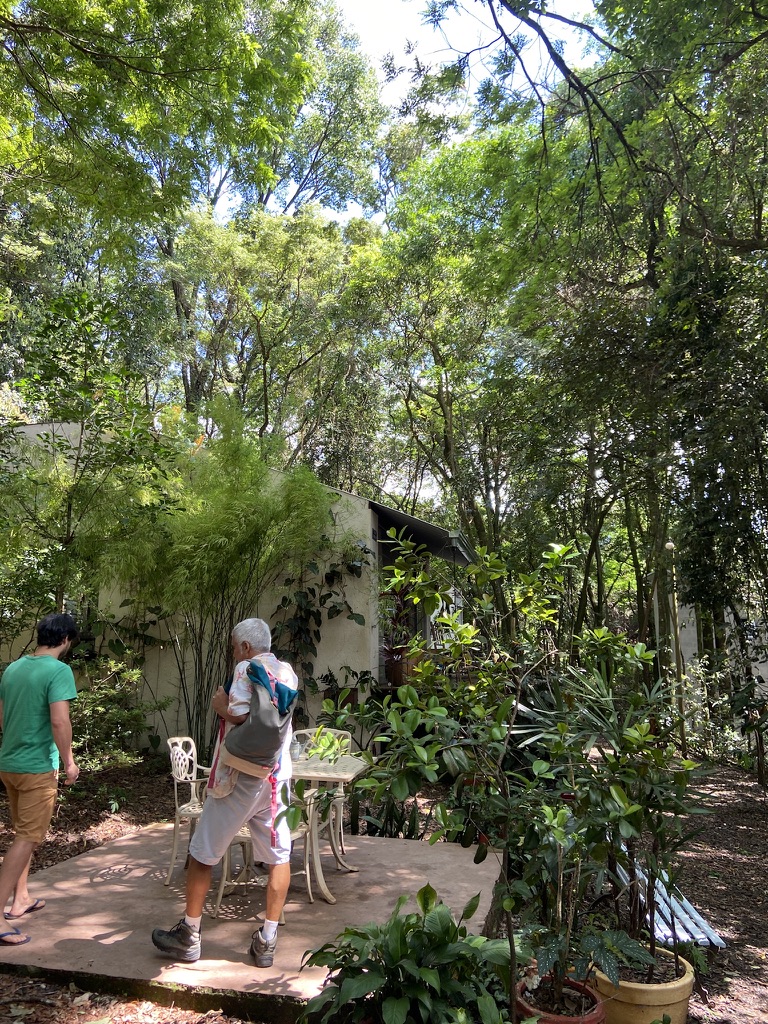 The house in the background, Adriano and Vitor in the foreground
The house in the background, Adriano and Vitor in the foreground Adriano listening to Vitor talk about... something... probably architecture
Adriano listening to Vitor talk about... something... probably architecture My friend Lara on the back porch.
My friend Lara on the back porch. Site Visit 2: Rebecca, her son and her partner in Casa Branca, Minas Gerais, Brazil. Jessica is SO COOL. She has a phd in agroecology and is currently an elementary school science teacher, with aspirations to integrate education and science. She currently drives over three hours every day to get to the school she teaches at, which is in Belo Horizonte. She lives with her family almost completely self-sufficiently. And she is beautiful and nice and smart and chill. So cool.

Rebecca with all her baby plants
 Rebecca’s son who got a mosquito bite and then rubbed a special kind of dirt on the bump to ease the itch
Rebecca’s son who got a mosquito bite and then rubbed a special kind of dirt on the bump to ease the itchSite Visit 3: Jéssica e Bebeto, a couple who has a ceramic studio that uses Japanese ceramic techniques and mixes it with forms, clay, and dyes from Minas Gerais. Jessica is from Aglomerado da Serra, a community/occupation (favela) in Belo Horizonte and started doing ceramics as a teenager in a course there. Bebeto is from somewhere else that I didn’t understand... I think a rural town in Minas Gerais?
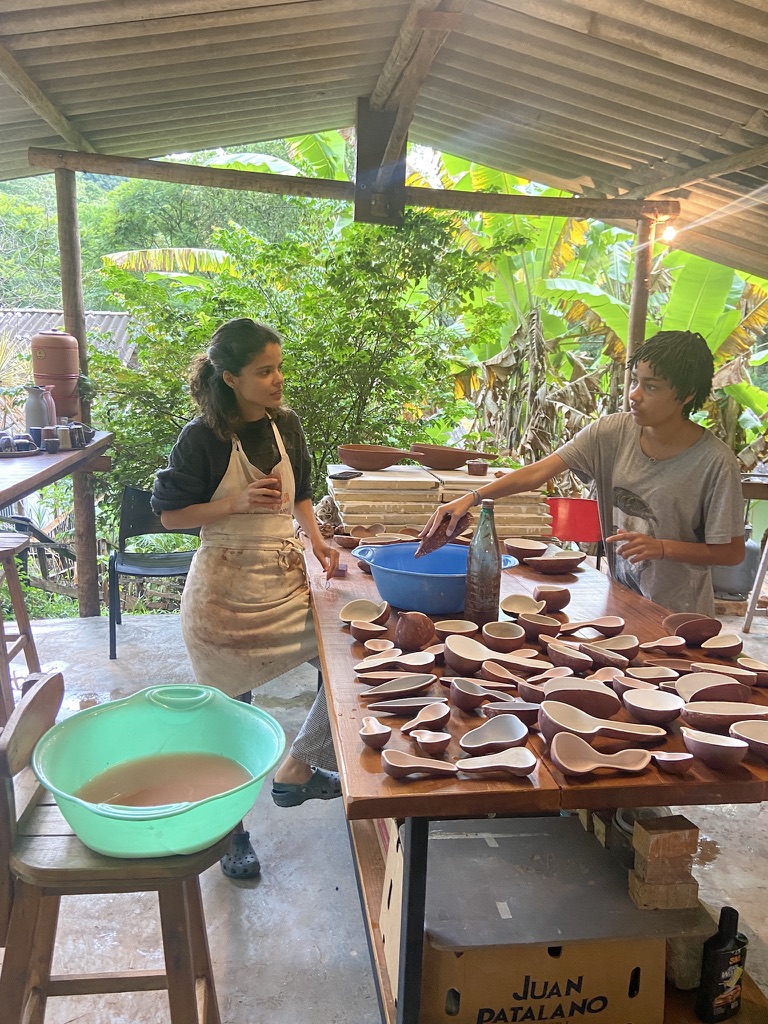
Jessica and her assistant glazing
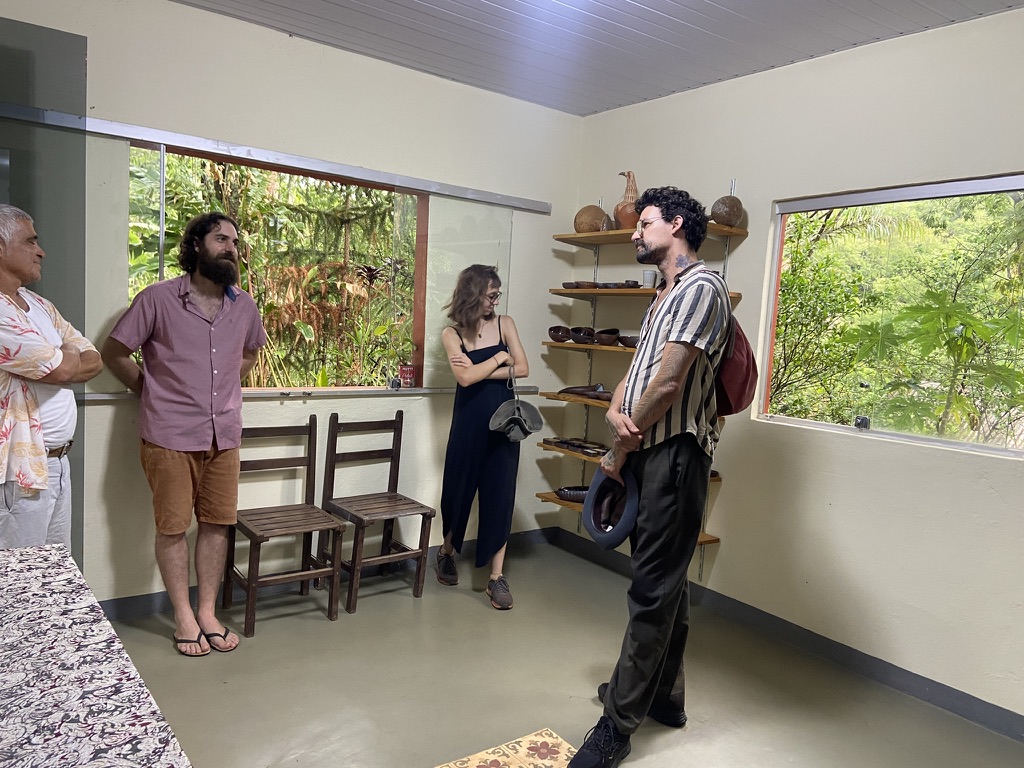 Bebeto in their shop @www.instagram.com/saracuratrespotes/
Bebeto in their shop @www.instagram.com/saracuratrespotes/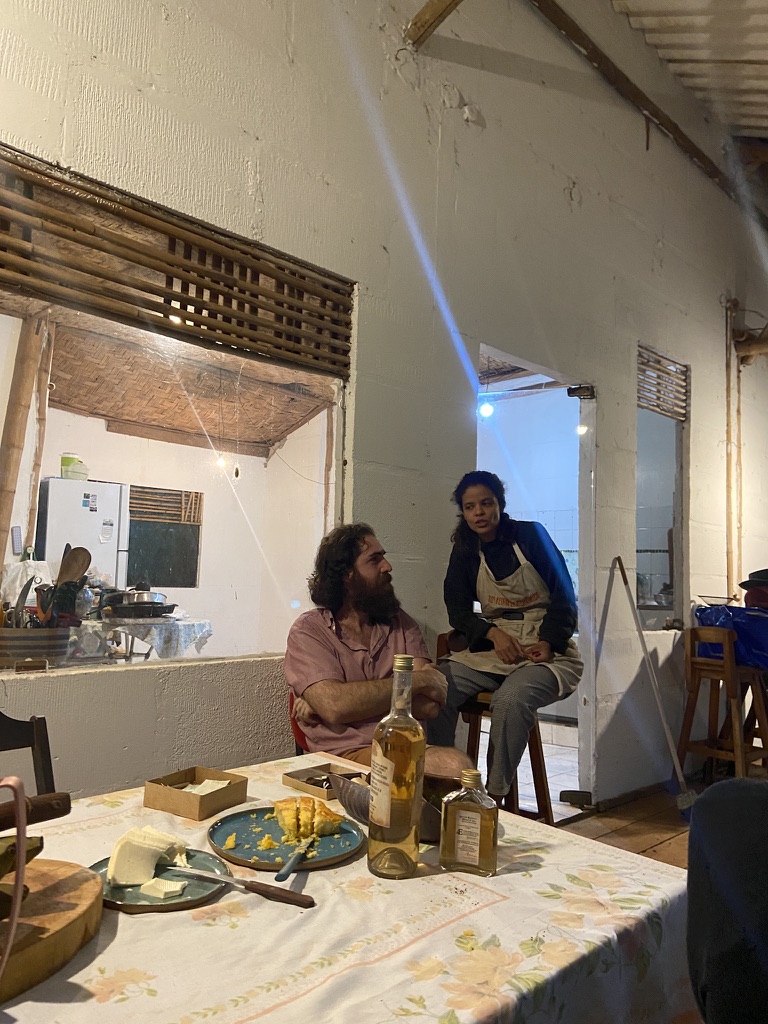 Jessica and Bebeto talking on their veranda with cheese, cornbread, cachaça, pão de queijo and cigars in the foreground
Jessica and Bebeto talking on their veranda with cheese, cornbread, cachaça, pão de queijo and cigars in the foreground Pink chimney is a heater that heats the hottub (next photo)
Pink chimney is a heater that heats the hottub (next photo)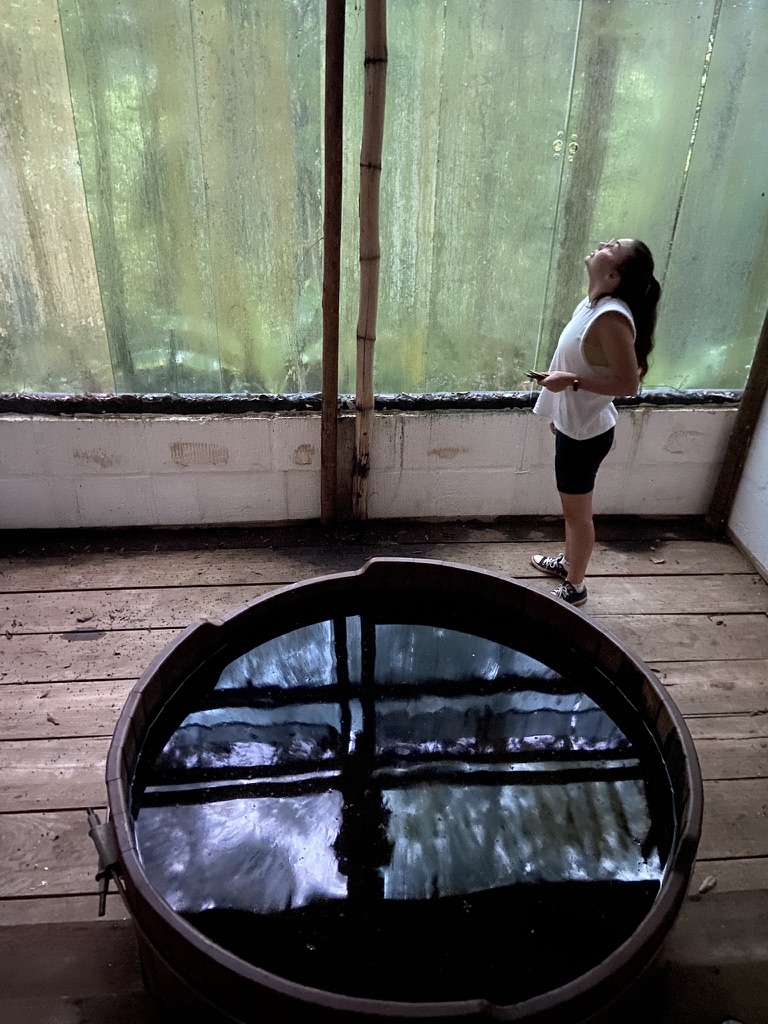
Hot tub
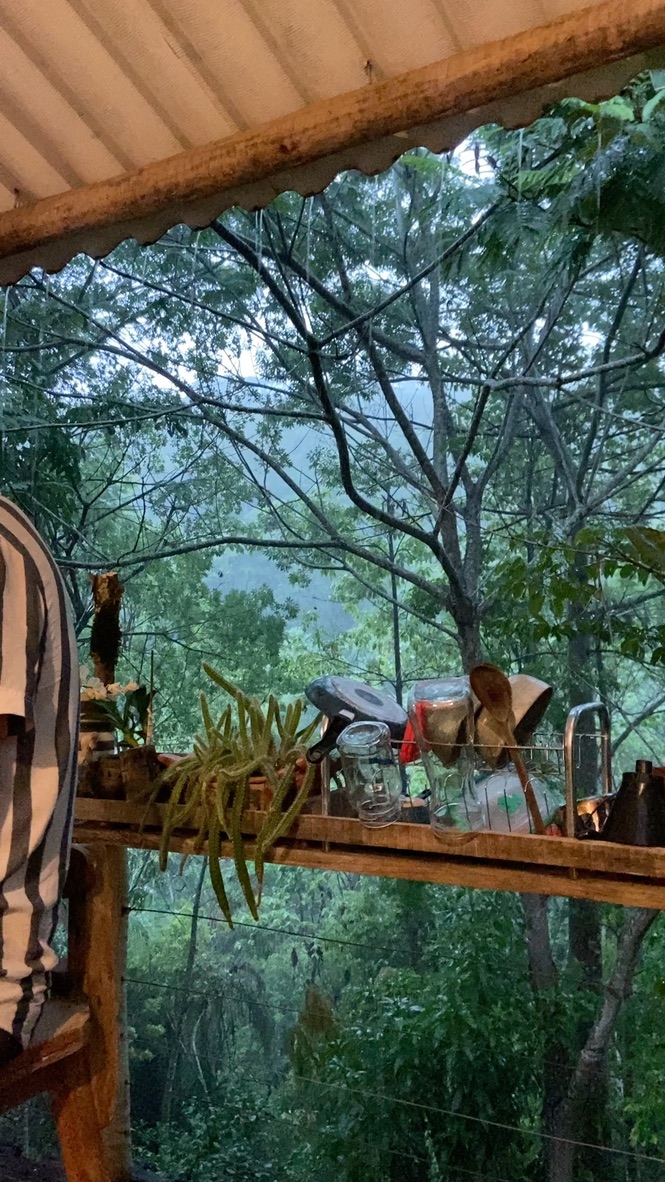
Dishes set out to dry on the veranda
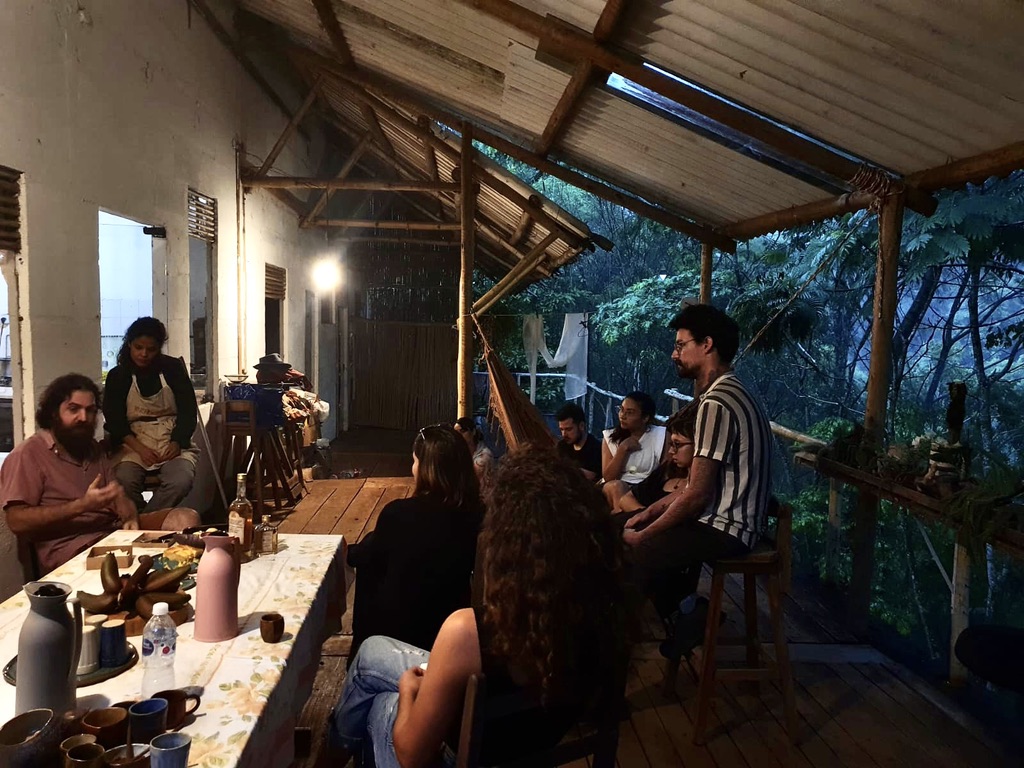
Back of the author’s head, foreground
Site visit 4: Joseane Jorge e do Benedickt. Joseane is a potter and chef from the region, Benedickt is a german ceramicist and Joseane’s partner. They live in this house and studio with Benedickt’s daughter. More photos here: https://www.instagram.com/ateliexakra88/
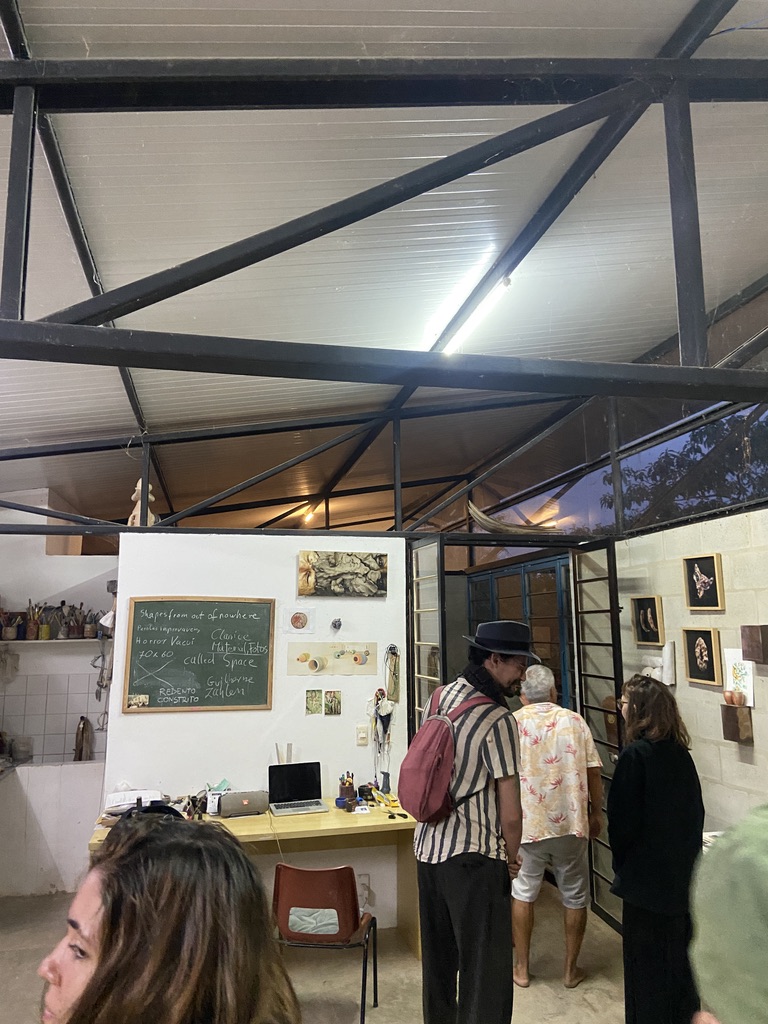
Ceramic studio
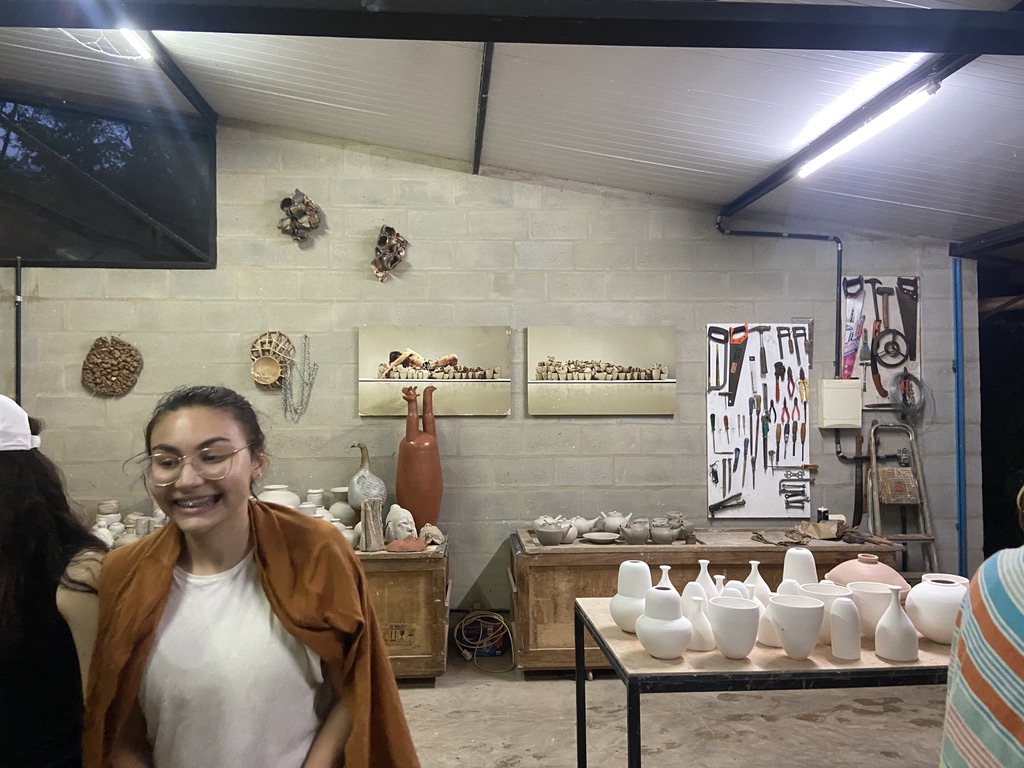
Ceramic studio
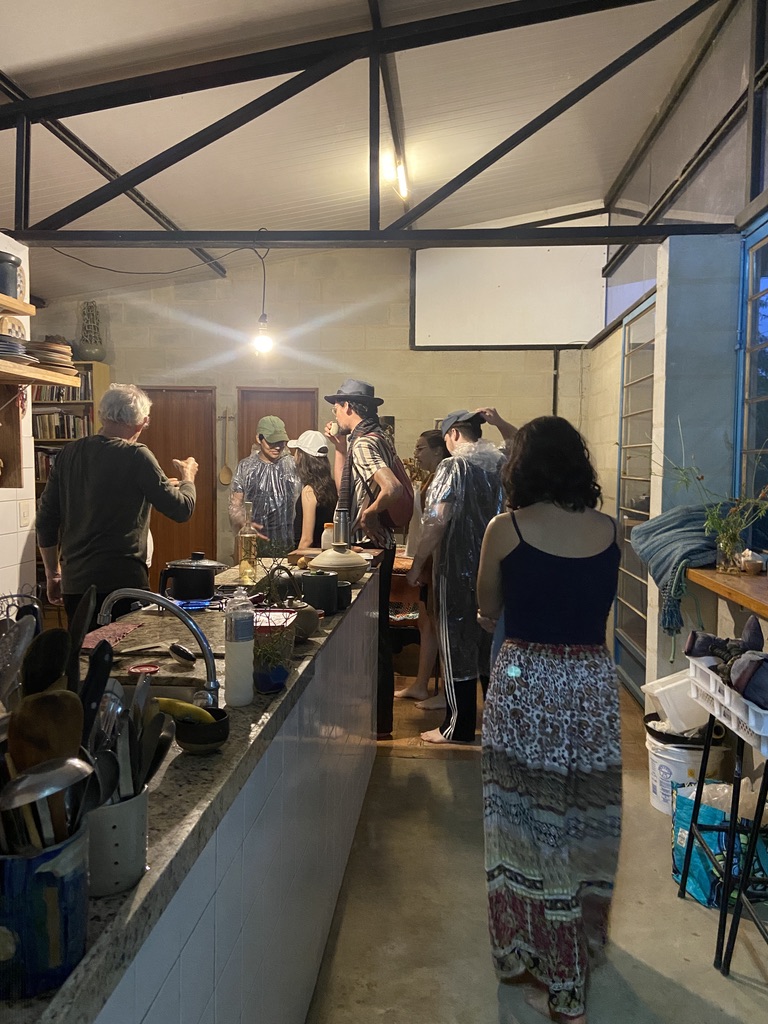
Adjacent kitchen to the ceramic studio
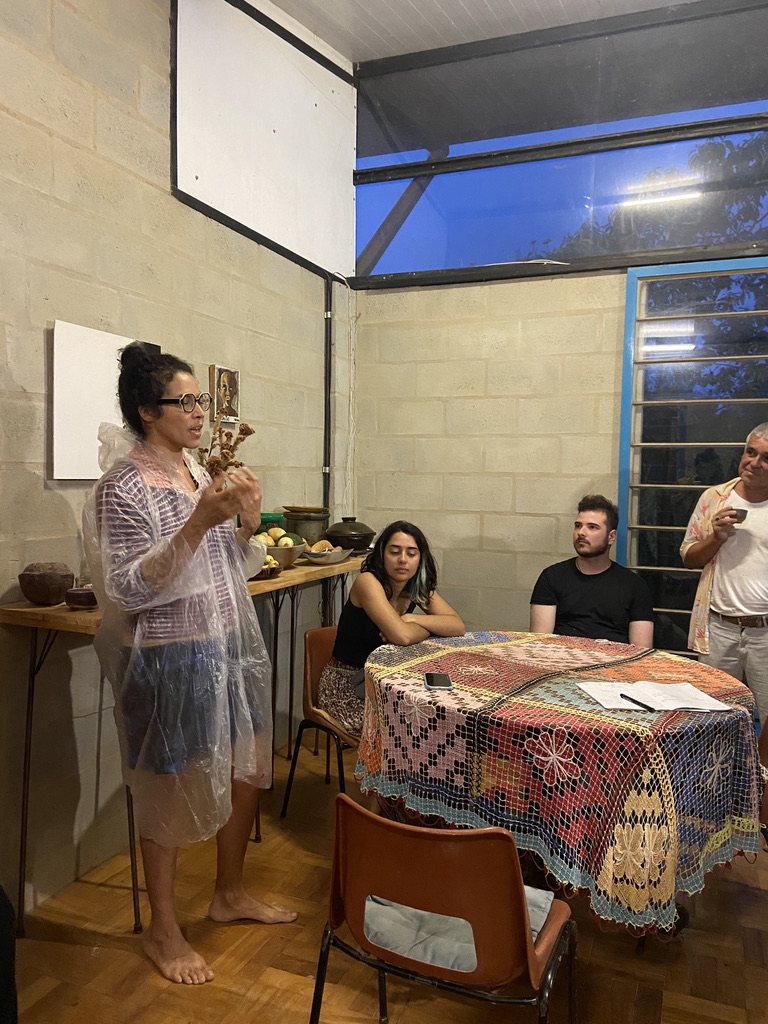
Joseane with her poncho in the kitchen
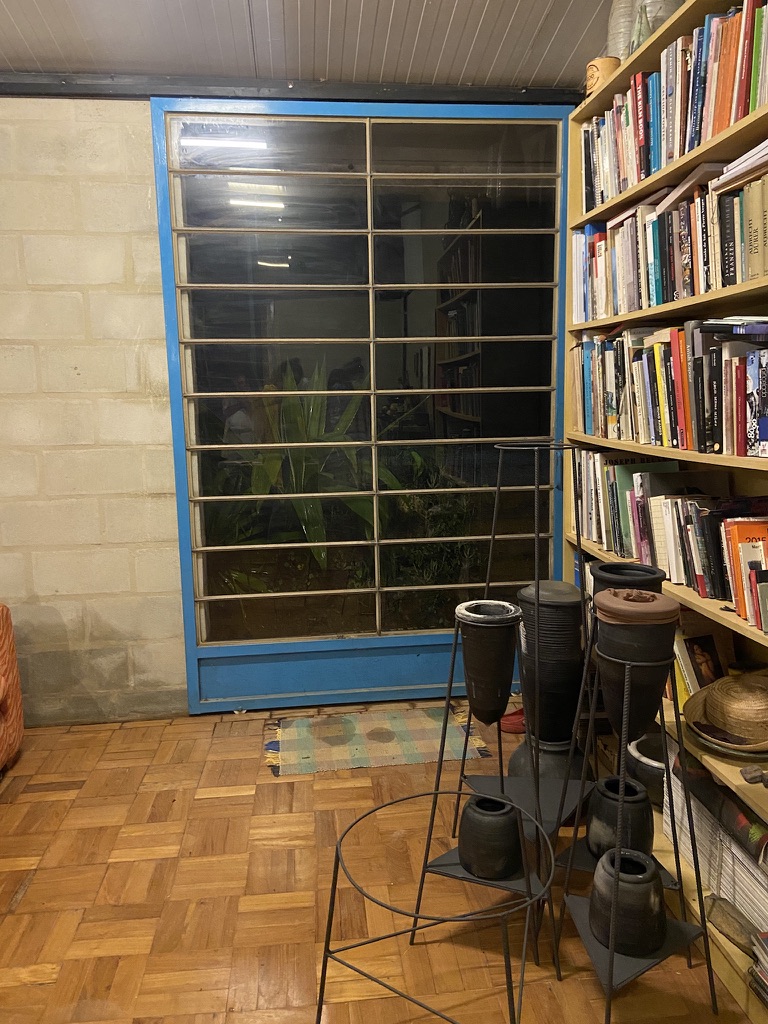 I love the blue of these windows and the dark clay of the pots in the foreground. The pots are an ancient sugar-making tool.
I love the blue of these windows and the dark clay of the pots in the foreground. The pots are an ancient sugar-making tool.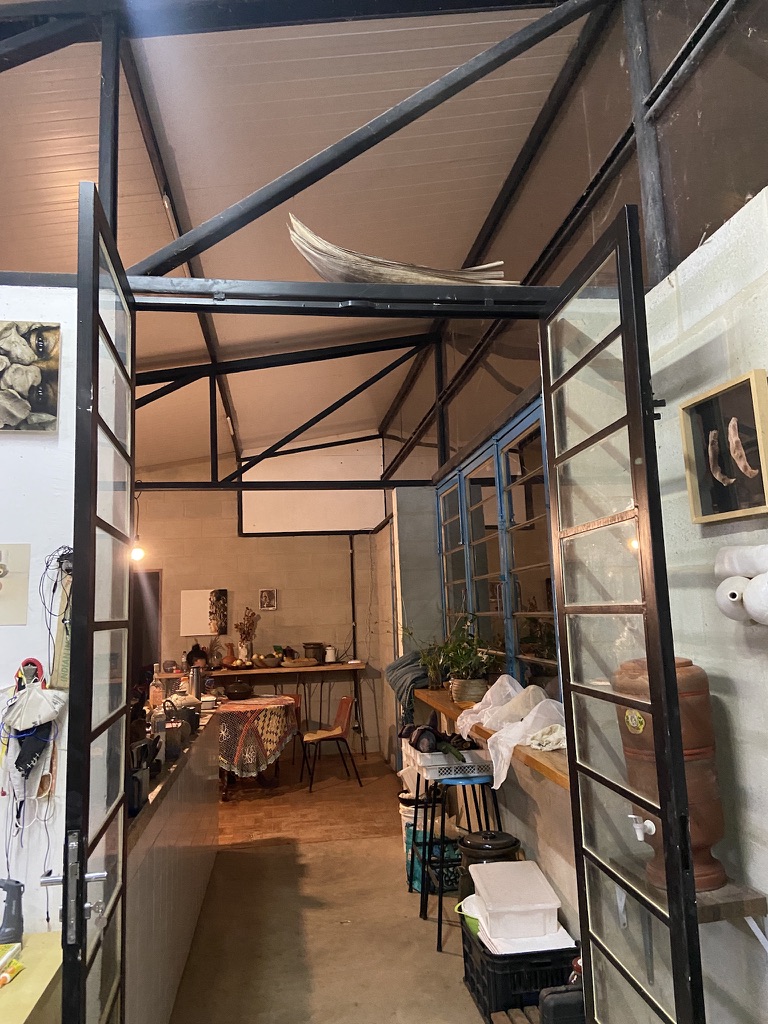 View from the ceramic studio into the kitchen. Joseane sitting at the table.
View from the ceramic studio into the kitchen. Joseane sitting at the table.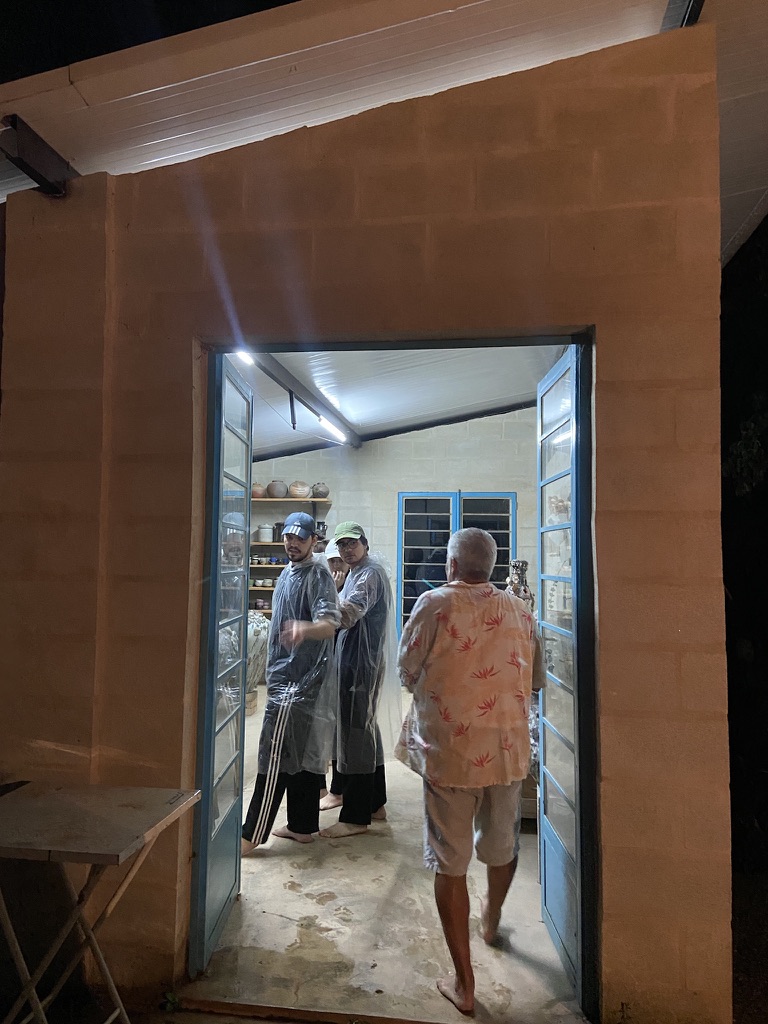
Adriano walking into the exhibition space behind the house.
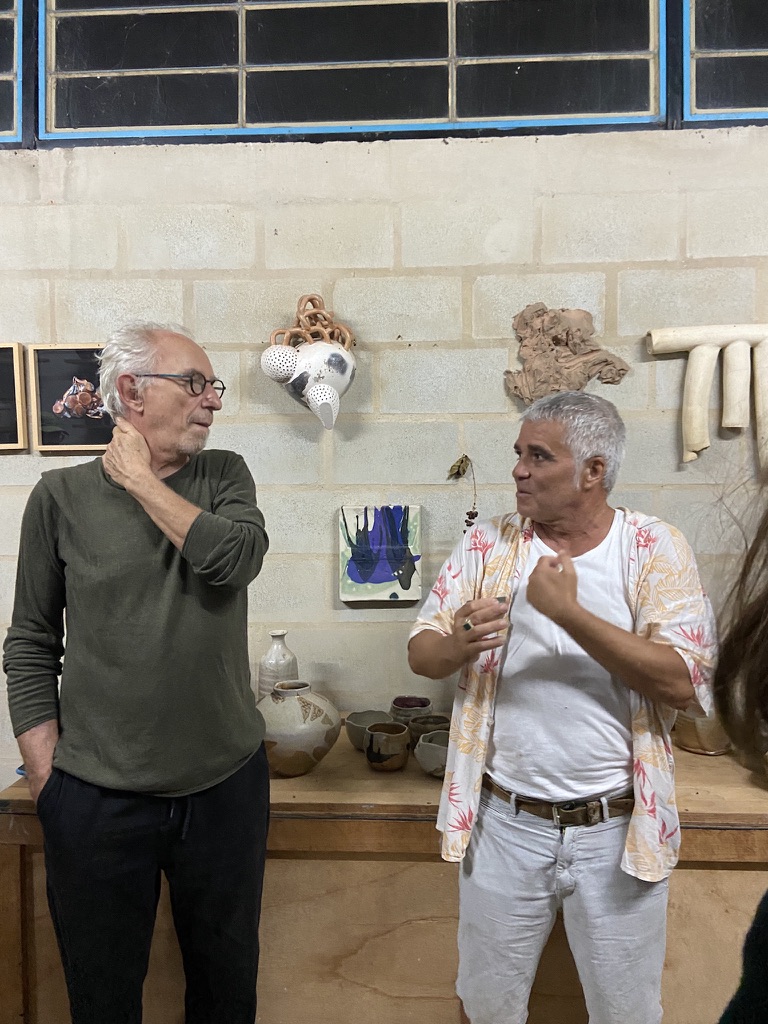
Benedickt and Adriano
↩️ Return to Blog